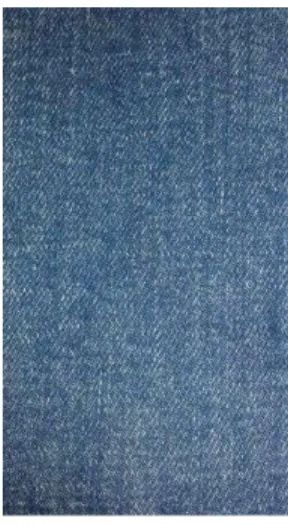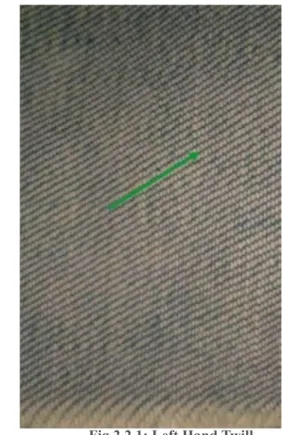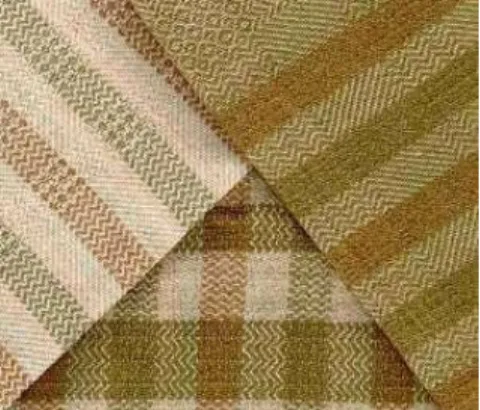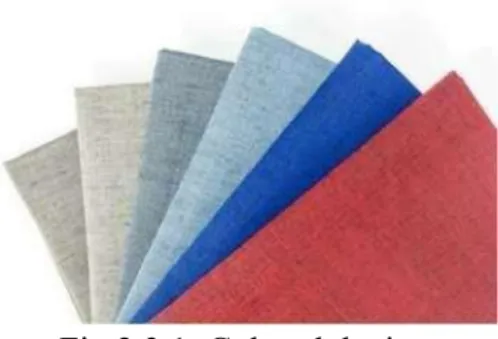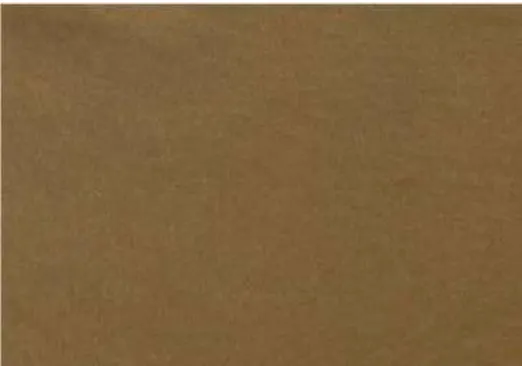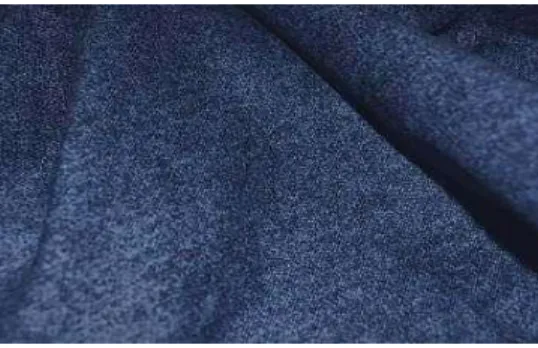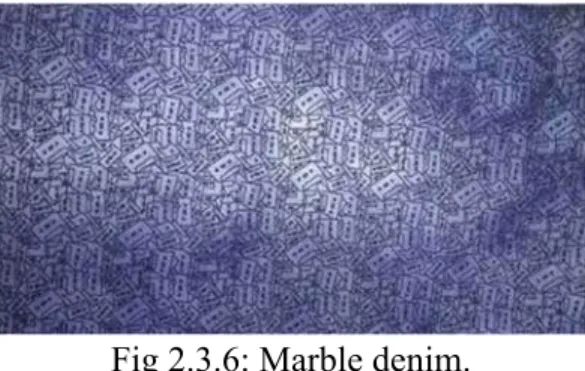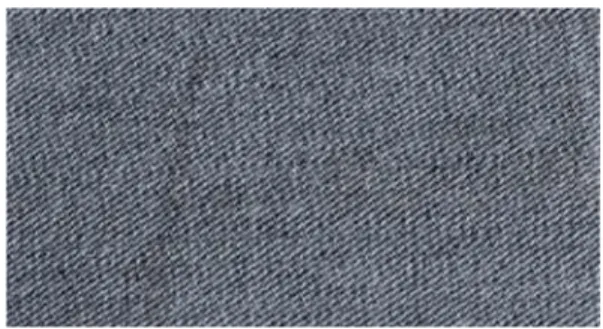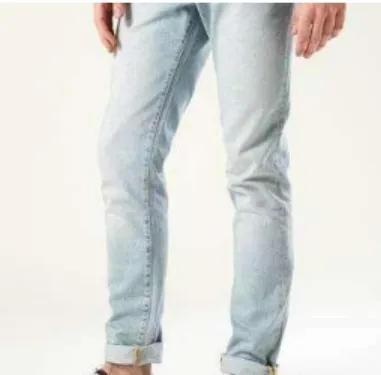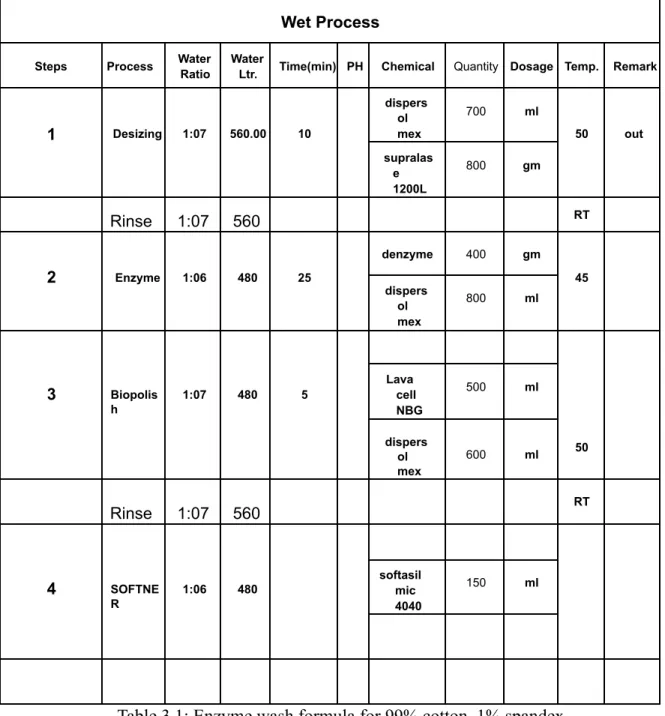Faculty of Engineering
Department of Textile Engineering
THESIS REPORT ON
Study on Different types of washing effect on denim garments
Course Title: Project ( Thesis) Course Code: TE 4214
Submitted By
Md. Sohel Rana 173-23-388 Md. Sumon Islam 173-23-377
Supervised By
Kazi Rezwan HossainLecturer
Department of Textile Engineering Faculty of Engineering Daffodil International University
This Report has Presented in Partial Fulfillment of the Requirements for the Degree of Bachelor of Science in Textile Engineering.
Advance in Apparel Manufacturing Technology December 2020
Letter of Approval
ToThe Head
Department of Textile Engineering Daffodil International University Ashulia, Savar, Dhaka
Subject: Approval of Project of B.sc in TE program Dear Sir,
I am writing this to let you know that, this thesis report titled as “Different types of wash effect on denim garments” has prepared by the students bearing are Md. Sohel Rana (173-23-388) and Md. Sumon Islam (173-23-377) is completed for final evaluation. The whole report has prepared based on the proper investigation and interruption through critical analysis of empirical evidence data with required belongings. The students were directly involved in their project activities and the report become vital to spark of many golden information for the readers.
Therefore, it will highly be appreciated if you kindly accept this Project and consider it for final evaluation.
Yours Sincerely
Kazi Rezwan Hossain Lecturer
Department of Textile Engineering Faculty of Engineering
Daffodil International University.
DECLARATION
We hereby declare that, this thesis report has been done by us under the supervision of Kazi Rezwan Hossain, Lecturer, Department of Textile Engineering, Daffodil International University.
We also declare that neither this thesis nor any single part of this thesis report has been submitted elsewhere for award of any degree.
Submitted by:
Name ID Signature
Md. Sohel Rana 173-23-388
Md.Sumon Islam 173-23-377
This is to certify that the above declaration is done by the candidates is correct to the best of our
knowledge.
Acknowledgement
At the very beginning we would like to express our deep appreciation to Allah for providing the opportunity to complete our thesis on date study on different type of wash effect on denim garments.
We would like to thank the management of Natural Denims Ltd. and Wash & Wear Ltd.
for giving us the opportunity to perform the Thesis effectively.
We are grateful and feel encumbrance to our Department HeadProf, Department of Textile Engineering, Faculty of Engineering, Daffodil International University. Special thank goes to our honorable supervisor Kazi Rezwan Hossain, Lecturer, Department of textile engineering,
Daffodil International University for providing his valuable suggestion and guidelines.
From our earnest Thanks to, Mahasinuzzaman Shishir, Deputy General Manager Natural Denims Ltd. and Wash & Wear Ltd. and our factory supervisor who supervised us & Zahid Hassan, Manager R&D in washing plant of Natural Denims Ltd. and Wash & Wear Ltd. for their teaching, supervising and advising during make our Thesis report. We hope their valuable information regarding to production process will help us lot for our engineering career.
DEDICATION
First of all, we would like to dedicate this thesis report to almighty Allah for giving us this opportunity to prove ourselves. Without Allah almighty helps nothing would be possible.
Then we would like to dedicate our report to our parents. We love them very much for completing our study they played an exigent role to complete this thesis. It is very pleasure for us. Without their help it would be impossible for us to complete this thesis. And we also would like to dedicate this report of our parents and our teacher.
ABSTRACT
This thesis report contains the all types of washing process and washing effect on denim garments of the industry. We have visited to ADTL collecting the related information for different type of washing process.
After executing all those processes, we have compared before and after wash effect. We completed washing process, recipe and different type of wash effect. Finally, we proposed to production system has been modeled and ensured the better productivity.
In this report, we discussed some procedure about different type of washing process, recipe and different type of washing effect and also discussed about analysis of different wash effect. After analyzing of different wash effect, we completed comparisons on it. Finally, we achieved result of different wash effect i. e. gray, blue, marbelish, cross hatch etc., shade, tone, hand feel, appearance and rejection percentage. For 70% cotton, 20% polyester ,8% rayon, 2% spandex denim garments-30% hand feel increase, 20% slubs visible, rejection (4-5) % and for 99%
cotton, 1% spandex denim garments 40% slubs visible and rejection (3-4) %.
Table of Contents
Letter of Approval ii
DECLARATION iii
Acknowledgement iv
DEDICATION v
ABSTRACT vi
CHAPTER-1 1
INTRODUCTION 1
1.1 Introduction 2
1.2 Nature of the work in washing 2
1.3 Objectives of the thesis 3
1.4 Importance of the thesis 3
1.5 Scope of the thesis 3
CHAPTER-2 4
LITERATURE REVIEW 4
2.1 Definition 5
2.2 Denim 5
2.2.1 Origin 6
2.2.2 Object of washing 6
2.2.3 Process Flow chart of Denim production 7
2.3 Feature of Denim 8
2.4 Types of denim fabrics 9
2.4.1 Colored denim 9
2.4.2 Bubble gum denim 9
2.4.3 Crushed denim 10
2.4.4 Vintage denim 10
2.4.5 Ecru denim 10
2.4.6 Marble denim 11
2.4.7 Reverse denim 11
2.5 Denim washing 12
2.5.1 Available of garments washing techniques used in ADTL 12
2.5.2 Desizing 13
2.5.3 Bleach wash 13
2.4.3 Enzyme wash 14
2.4.4. Acid wash 16
CHAPTER-3 19
METHODOLOGY 19
3.1 METHODOLOGICAL DETAILS 20
3.2 Buyer Requirement sheet 20
3.2.1 Enzyme wash 23
3.3 Stone Enzyme wash 26
3.3.1 Stone Enzyme wash 29
3.4 Bleaching wash 32
3.4.1 Bleaching wash 35
3.5 stone Acid wash 38
Chapter-4 44
RESULT AND DISCUSSION 44
4.1 Result and Discussion 45
4.2 Analysis of enzyme wash on denim garments between two type of fabric composition,
data from: 3.1 & 3.1.1 45
4.3 Analysis of stone enzyme wash effect on denim garments between two type of fabric
composition, data from: 3.2 & 3.2 2
4.4 Analysis of bleach wash effect on denim garments between two type of fabric
composition, data from: 3.3 & 3.3.1 2
4.5 Analysis of stone acid wash effect on denim garments between two type of fabric
composition, data from: 3.4 & 3.4.1 2
Chapter-5 2
CONCLUSION 2
5.0 Conclusion 3
Chapter -6……….4 REFERENCE………...4 6.0 Reference……….……...4
Figure list
Fig 2.1: Denim fabric 5
Fig 2.2: Right hand twill 8
Fig 2.2.1: left hand twill 8
Fig 2.3.1: colored denim 9
Fig 2.3.2: Bubble gum denim 9
Fig 2.3.3: Crushed denim 10
Fig2.3.4: Vintage denim 10
Fig 2.3.6: Marble denim 11
Fig 2.3.7: Reserve denim 11
Fig 2.4: Bleach wash 14
Fig 3.0: Before wash 23
Fig 3.2.1: After wash 23
Fig 3.2.2: After stone enzyme wash 30
Fig 3.3.1: Before wash 36
Fig 3.3.2: After Bleach wash 36
Fig 3.3.3: Before bleach wash 39
Fig 3.3.4: After bleach wash 39
Fig 3.4.1: Before wash sample 42
Fig 3.4.2: After stone acid wash 42
Fig 3.4.3: Before wash 45
Fig 3.4.4: After stone acid wash 45
List of charts
Chart 4.1: Analysis of before wash on denim 46
Chart 4.1.1: Analysis of enzyme wash effect on denim garments 46
Chart 4.2: Analysis of before wash on denim garments 48
Chart 4.2.1: Analysis of stone enzyme wash effect 48
Chart 4.3: Analysis of before wash 50
Chart 4.3.1: Analysis of bleach wash effect 50
Chart 4.4: Analysis of Before wash 52
Chart 4.4.1: Analysis of stone acid wash effect 52
List of Table
Table 3.1: Enzyme wash formula for 99% cotton,1% spandex 22 Table 3.1.1: enzyme wash formula for 70% cotton ,20%polyster ,8%rayon ,2% spandex 25 Table 3.2: Stone enzyme wash formula for 99% cotton,1% spandex 29 Table 3.2.1: Stone enzyme wash for 70% cotton ,20%polyster ,8%rayon ,2%spandex 32 Table 3.3: Bleach wash formula for 99% cotton,1% spandex 35 Table 3.3.1: Bleach wash formula for 70% cotton ,20%polyster ,8%rayon ,2% spandex 38 Table 3.4.1: Stone acid wash formula for 70% cotton ,20%polyster ,8%rayon ,2% spandex 39
CHAPTER-1
INTRODUCTION
1.1 Introduction
Industrial washing is one of the important applied finishing methods on fabric and garments.
Different Type of washing method can be applied on denim garments finishing. To required special outlook and appearance as well as to change the fashion. The washing methods are stone wash, bleach wash, enzyme wash, towel wash, acid wash, pp wash is mainly responsible to produce fashionable shade. Denim fabric produced from the twill weave including wrap yarns dyed with Sulphur/indigo color and undyed white weft yarns. From some years ago we were already using fully biodegradable enzymes and some chemical which are environmentally nontoxic in the modern textile finishing process. A number of mechanicals of chemical operations can be replaced by enzymatic treatment, which have been applied to develop fabric quality. Recently some reports have been published to analyze the change of textile’s color after applying in different finishing methods as clients when choosing an item from shop always pay attention to its color and appearance. Specification of fabric (EPI, PPI, surface density, warp &
weft linear density, GSM) Fabric tensile strength, fabric stiffness, seam strength, etc. Must be treated as important features as those determine wear durability and longevity. However, as important enzyme wash on the changes of above features is clearly evaluated in this report.
1.2 Nature of the work in washing:
Denim garment washing is known as one of the widely used important treatment that has vast usage in textile sectors because of creating special appearance and making fashionable and wear comfortable garments of the present day of the world. For this it is essentially needed for a finishing treatment to make it softer, smooth and comfortable to wear performance. Washing is one of the most important finishing treatments applied on apparels to produce special appearance and improving the fashion. Technologically denim washing is the most important fashion element for garments industry. Industrial washing is one of the most important applied finishing methods on fabric or garments. Different washing methods can be used in case of denim fabrics finishing. To achieve special appearance as well as to change the fashion, responsible washing methods are stone wash, sand wash, bleach wash & enzyme wash, acid wash. The uses of enzymes in textile industry are one of the most swiftly growing fields in industrial enzyme specialized. The enzymes used in the textile field are catalane, and lactase which are used to dispelling the starch, degrading excess H2O2, bleaching textiles and degrading lignin.
1.3 Objectives of the thesis:
Textile is the most important area of earning foreign currency so it is essential to rapid development of washing technology of a company especially in Textile industries. Practical knowledge is more effective than academicals knowledge and so it will fulfill the experience through theoretical as well as practically. The main objectives of this study-
● To evaluate the Apparel washing process.
● To observe the different type of shade effect in this process.
● To figure out some problems of critical washing process.
● To analyze the difference between before wash garments and after wash garments.
● To identifying the shade variation of same wash process.
● To find out the limitations of critical wash process.
1.4 Importance of the thesis:
A combination between our academical education line and practical life with various article, documents and calculation. A large number of foreign currencies are earned by textile sector around 81% to 86%. The importance of this thesis is to determine the different types of wash effect in denim garments. For this inquisition currently fashionable regular denim (100% cotton with twill 3/1 weave construction) garments was chosen.
1.5 Scope of the thesis:
● Huge opportunities to do some things in denim garments washing industry.
● Nowadays the washing demand increasing day by day.
● Ready Made Garments is given so much opportunity for implementing new techniques of washing sector.
● It is an interesting topic so that almost all industries are giving chance for evaluating about washing process and wash effect to increasing productivity.
CHAPTER-2
LITERATURE REVIEW
2.1 Definition:
The technology which is used to modify the appearance, outlook comfort ability & fashion of the garments is called washing & it is normally processed after sewing.
2.2 Denim:
Denim is the unique apparel preferred by all age groups and due to its beloved of all. Denim is a rugged cotton twill weave textile in which the weft passes under two or more warp threads. This twill weaving produces the familiar diagonal line (left to right & right to left) of the fabric, which distinguishes denim from cotton duck. Denim though considered being one of the oldest fabrics in the world yet remains fresh even till now.
The warp yarn is basically dyed with the blue pigment obtained from indigo dye. Indigo dye was the most yarn is traditionally dyed with the blue pigment obtained from indigo dye. Indigo was the most important figure natural dye known to mankind until the introduction of synthetic dyes, at the end of the 19thcentury.
Fig 2.1: Denim fabric
Denim industries are now, more than at any time previously spending huge amounts of money in developing new concepts which in term means that all denim manufactures will experiment with and achieve new levels of finishing.
2.2.1 Origin
The world denim comes from the fabric called serge, originally made in Nimes, France, by the Andre family. Genuinely called Serge de Nimes, the name was soon shortened to denim. Denim garments have been used in America since the late 18thcentury.
Denim was the traditionally colored blue with indigo dye to make blue “jeans”, although “jean”
then illustrate a different lighter cotton textile; the contemporaneous use of jeans comes from the French word for Genoa, Italy, there the first denim trousers were made.
2.2.2 Object of washing:
There are a few objects of denim garment washing:
1. To develop softness in garments: Size materials applied during manufacturing that are present in the fabric are removed, which raise the soft hand feel. Additional softness may be performed by using softeners.
2. To introduce a fading effect: Dyes and pigments are present in the fabric, used during coloring, are washed out locally or partially, resulting in fading or worn-out effects in the garment products.
3. To create new fashion: The washing process of garments creates a different outlook (faded, color tinted, etc.), thus building new fashions for new generations especially for teenagers.
4. To satisfy the consumer: Because contraction or extraction (shrinkage) does not occur during washing, the wearer can use the garments satisfactorily after getting them.
2.2.3 Process Flow chart of Denim production:
Spinning
↓ Bale warping
↓ Rope dyeing
↓
Long Chain Beaming
↓ Sizing
↓ Weaving
↓ Finishin
g
↓
Inspection & Folding
↓ Packing
↓ Dispatch
2.3 Feature of Denim:
Typical denim fabrics are woven from unmelodious, indigo-dyed cotton yarn. These are highly density fabrics with a high mass per unit area. Today, more denim is produced in the world than any other type of garments.
● Usually, the warp is colored and weft is gray or white.
● It is a cotton –polyester blend, durable heavy weight, twill weave and yarn dyed fabric (actually warp yarn dyed).
● Denim is warp-faced twill and the colored warp yarns predominate on the face and the white weft yarns on the back.
● It is available in different weight range from 203.46gm/m2(6 oz/yd2) to 474.74 gm/m2 (14.6 oz/yd2) or more in 2 up 1 down or 3 up 1 down interlacing pattern.
● To control shrinkage, GSM, wrinkling commonly blended with spandex.
Fig 2.2: Right Hand Twill Fig 2.2.1: Left Hand Twill
The feature of the diagonal surface texture. The twill line can follow upward to the right (right- hand twill) is called “S” twill or upward to the left (left-hand twill) is called “Z” twill diagonal
direction. Both will function as a denim
fabric, but the width and angle of the diagonal line will change the more yarns floated over the shallower diagonal direction, the more pronounced the diagonal lines. A fewer number of yarns floated over, and the steeper the diagonal direction, the less noticeable the diagonal lines.
2.4 Types of denim fabrics:
2.4.1 Colored denim:The colored denim fabrics are woven, manufacturing with dyed yarn either warp or weft. This kind of fabric can be obtained by piece dying process.
Fig 2.3.1: Colored denim.
2.4.2 Bubble gum denim:Bubble gum denim fabrics are lycra containing denims, those have between 35% to 50% lycra or stretch.
Denim fabric is from fox fiber: These gum denim fabrics are manufactured by colored cotton fiber that grows naturally developed and patented by California cotton breeder sally box.
Fig 2.3.2: Bubble gum denim
2.4.3 Crushed denim: In crushed denim fabrics, textured effect achieved through a special fabric construction along with wet processing. Where the effect can also be decorated by using stone and bleach. This kind of denim fabric is woven with a twist weft yarn.
Fig 2.3.3: Crushed denim
2.4.4 Vintage denim: To achieve old and worn appearance a denim treatment that applies heavy stone wash or a cellulose enzyme wash or without bleach is called vintage denim.
Fig 2.3.4: Vintage denim.
2.4.5 Ecru denim:Ecru denim fabric is that which is not having any dyed yarn, contains only grey yarn in warp in weft.
Fig 2.3.5: Ecru denim.
2.4.6 Marble denim:Marble denim has another operational use of acid wash. If the garments are strongly bleached, then it is called marble denim.
Fig 2.3.6: Marble denim.
2.4.7Reverse denim:Reverse denim fabric is that, where the face side and reverse side looks the same.
Fig 2.3.7: Reverse denim.
Different between of denim and jeans:
SL No. Denim Jeans
01 Denim is a fabric and It is made from 100% cotton twill or stretch twill.
Jeans one kind of garments which is made by using denim fabric.
02 Denim fabric is durable. It is durable but dependent on how it was processed from denim fabric.
03 All denims are not jeans. All jeans are denim.
04 Denim is fashionable fabric, by which different types of apparels style can be produced.
Jean is only a particular style of apparels.
05 Denim can be defined either jackets, cap, shirt, skirts, pants, shorts etc.
Jean is specially defined at denim pant only.
2.5 Denim washing:
Denim washing is the aesthetic finish given to the denim garment to enhance its appearance and provide strength. The emphasis is for bringing comfort and softness on it. Fashion trends favor the broken-in appearance and worn/faded seams that can only be achieved through garment processing. Much of the apparel of dry denim lies in the fact that with time the fabric will fade in a manner of similar to that which artificially distressed denim attempts to replicate.
2.5.1 Available of garments washing techniques used in ADTL:
2.4.1.1 Dry process:
● Hand whiskering.
● Hand scrapping.
● Resin (3D effect).
● Tagging.
● Grinding and destroy.
● P.P spray.
● Laser.
● Crinkle effect 2.4.1.2 Wet process
● Normal wash.
● Desizing process.
● Enzyme wash.
● Stone enzyme wash.
● Bleach wash.
● Enzyme + stone+ Bleach wash.
● Acid wash.
● Pigment wash.
● Tinting.
● Random wash.
● Towel wash
2.5.2 Desizing:
Desizing is the process of removing the size material from the warp yarns before weaving is done. This is the most fundamental part of denim washing.
During sizing, the warp yarn threads are treated with auxiliary chemicals known as sizing chemicals which impart the strength, friction resistance during weaving. The purpose of sizing is to protect the warp yarn by coating. Different types of sizing chemicals are used in desizing process like starch, modified starch, polyester, poly-acrylates, polyvinyl alcohol, polyvinyl acetate, CMC etc. during washing, those chemicals should be removed to bring desired look on the fabric.
2.5.3 Bleach wash:
Bleach wash refers the light blue shade of denim. This Bleaching is usually done by strong oxidizing agents. In denim washing industry, most extensively used chemicals are sodium hypo-chlorite, calcium hypo-chlorite, hydrogen per oxide and potassium permanganate.
Fig 2.4: Bleach wash
2.4.3 Enzyme wash:The Enzyme is a living biochemical substance and it works as a catalyst in the washing bath. In the washing process firstly enzyme hydrolysis the cellulose and remove the projecting fibers from the fabric surface, therefore faded effects are found by this wash. For getting excellent fading effect on garments, enzyme wash is a most essential wash in the garment industry.
2.4.3.1 Objectives of enzyme wash:
● To dispel the size materials from the denim garments.
● To achieve the high & low abrasion on garment and seem abrasion in sewing area.
● To dispel the present starch on the garments
● Enzyme attacks as chemically not mechanically as a result low damage/wastage then stone wash.
● To improve the color fastness & rubbing fastness to the garments.
● For achieving soft feeling to wear the garment.
● Enzyme increases the anti-pilling properties.
● Enzyme attacks more on the surface of the fabrics and gives a very smooth surface.
2.4.3.2 Types of enzyme:
Mainly two types of enzyme used in Bangladesh. These are – 1. Acid enzyme.
2. Neutral enzyme.
a Powder from.
b Liquid from i.e., SL enzyme.
2.4.3.3. Acid enzyme:
● Acid enzyme looks slightly brown.
● Enzyme effects come within very short time.
● Required pH range is 4.5 to 5.5.
● Temperature required 400c to 500c.
● Required time is 20 - 30 min (according to shade).
● Color staining occurs more in garments.
2.4.3.4. Neutral enzyme:
a) Powder from
● It is found as powder from.
● Effect comes slowly.
● Less color staining on garments.
● Required pHrange is 6 to 7.
● Required temperature is 450cto 600c.
● The required 30 min to 50 min (according to shade).
b) SL ENZYME:
● It is liquid from
● Effect comes slowly
● Less staining on garments
● pH range is 6 to 7
● Temperature 45 to 60 c.
● Time required 30 to 50 min (according to shade).
2.4.4. Acid wash:
An acid wash finish treatment creates significant contrasts in the color shade of the denim material. Its style came into vogue in 1980s, the process of treating denim in such a way began to become increasingly refined. Some tried to use a method same to the stone washing, yet the fading did not occur as dramatically or throughout the material. Acid washed on apparel (phosphoric Acid is used in the process, acid would react with fabric surface and destroy the fabric) is washed with pumice stone until it is bleach almost white. During acid wash, thermocol balls or Pumic stones are used. By the action of thermocol ball or pumice stone irregular fading effect is developing on the heavy garments like denims, thick canvas /twill and sweater. The thermocol balls or pumice stones act a brushing action on the garment’s fabric surface is supersize your silhouette in this slouchy denim or jeans jacket in vintage acid wash. In the garments area where more brushing action takes place less brushing action and takes place less fading effect will be developed. The multi-layer fabric areas like -collar, calf, pocket, zipper fly, belt, placket and side seam area will be brushed more than the single layer areas. As a result, irregular fading effect will be developed on the garments fabric surface to new fashion. Thus, in the way fading effect from the garments may be developed on the garment by acid wash technique.
2.4.4.1. Objectives of acid wash:
● To create uneven fading shade or old looking effect.
● To get novelty in look (that must be something new look).
● To get the buyer washing standard.
● To improve rubbing fastness.
2.4.4.2. Types of acid wash:
a Acid wash by stone.
b Acid wash by towel.
c Acid wash by crock-sheet.
2.4.4.3. Acid wash by stone:
Firstly, pumice stones are must be soaked by solution of strong oxidizing agents like sodium hypochlorite 5-10% (NaOCl) or potassium permanganate (KMnO4) (3-6%). Excess liquor should be removed from the stones. Particular number of treated stones and garments is dry tumbled in the garments is called acid washing or snow washing or ice or stone washing. Stones can be treated by following two ways -
1. Stones are basically taken into a net or mesh fabric and soaked into the solution then dried for the next process.
2. A residual piece of fabric is placed into the belly dyeing machine. Then stones are gathered together on the fabric and the solution is sprayed on those stones and run the machine for 2- 3 min by tumbling to remove excess solution and also to mix them properly.
KMn04 + H2O + H3P04 = Solution- Add stones Soaking
The soaked stones and wetted garments are loaded into the dyeing machine. According to the expected fading effect, the machine is tumbled 2-10 min. The color fading depends on the belly machine. According to the desired fading effect, the machine is tumbled 2 min to 10 min. Color fading depends on the given stone ratio, concentration of the dyestuffs, types of garments. After getting the required effect the garments are loaded on another dyeing machine for rinse for 3-4 min. As KMnO4 or NaOCl are hazardous/toxic chemical so neutralization is mandatory for further processing. If KMnO4 is used, then MnO2 is formed which turns to brown or orange tone and must be removed by oxalic acid and if NaOCl is used then a reducing agent like sodium bi-sulfite is used for neutralization. Finally, the garment treated by softening agents then hydro extracted and dried by dryer.
2.4.4.4.Towel wash: At present occasions, the most well-known denim pieces of clothing are irregular washed among the in vogue separate. At the point when strong washed the blurring, impacts are even and uniform in the pieces of clothing however when arbitrary washed impacts are not uniform. The initial step of corrosive wash is flush if necessary, then desized by protein (alpha amylase) or by desizing synthetic compounds as pointed by the texture of the article of garments. At that point wash by cellulosic proteins if necessary, to achieve scraped spot impacts. After those arbitrary wash processes begin by making potassium permanganate (KMnO4) or dye (NaOCl) arrangement with required measure of water or phosphorous corrosive and uneven impact making components like stones, balls, towels, and thermopiles. To expedite irregular impacts articles of clothing must be wet so the pieces of garments should be hydro removed before tossing to the midsection machine.
CHAPTER-3
METHODOLOGICAL DETAILS
3.1 METHODOLOGICAL DETAILS:
We collected this report from Natural Denims Ltd. We completed this report by following several processes like desizing, enzyme, bleach, acid etc.
3.2 Buyer Requirement sheet
3.1Enzyme wash
Natural Denims Ltd Buyer name: H&M
Quantity: 150
Fabric composition: 99% cotton, 1% spandex
Enzyme wash
Natural Denims Ltd Washing formulaBuyer: H&M quntity:150 weight:80kg Fabric composition: 99% cotton, 1% spandex
Wet Process
Steps Process Water Ratio
Water
Ltr. Time(min) PH Chemical Quantity Dosage Temp. Remark
1 Desizing 1:07 560.00 10
dispers ol mex
700 ml
50 out
supralas e 1200L
800 gm
Rinse 1:07 560 RT
2 Enzyme 1:06 480 25
denzyme 400 gm
dispers 45 ol mex
800 ml
3 Biopolis
h
1:07 480 5
50 Lava
cell NBG
500 ml
dispers ol mex
600 ml
Rinse 1:07 560 RT
4 SOFTNE
R
1:06 480
softasil mic 4040
150 ml
Table 3.1: Enzyme wash formula for 99% cotton ,1% spandex
Fig3.0: Before wash(sample) Fig 3.1: After enzyme wash
Description: The table remain enzyme wash of denim washing for 99% cotton, 1% spandex.
Firstly, we did desizing process and we used dispersal mix and supralase 1200L with liquor.
After desizing we used denzyme and dispersal mex with liquor for enzyme wash. Then we finished this wash by bio polish and softener. Finally, we did 2 times rinse wash. After rinse wash, garments go through the hydro-extractor and dryer. Finally, we got the finished garments.
3.2.1 Enzyme wash
Natural Denims ltd.Buyer name: ESPIRIT Quantity: 150
Fabric composition: 70% cotton, 20% polyster,8% rayon, 2% spandex
Enzyme wash
Natural Denims ltd.Washing Formula
Wet Process
Steps Proces s
Water Ratio
Water
Ltr. Time(min) PH Chemical Quantity Dosage Temp. Remark
1 Desizing 1:07 560.00 10
dispersol mex 700 ml
50 out
supralase 1200L 800 gm
Rinse 1:07 560 RT
2 Enzyme 1:06 480 25
denzyme 400 gm
45 dispersol mex 800 ml
3 Biopolish 1:07 480 5
50 Lava cell NBG 500 ml
dispersol mex 600 ml
Rinse 1:07 560 RT
4 SOFTNE
R
1:06 480 softasil mic
4040
2 L
Rinse
2× RT
Buyer: ESPIRIT quntity:150 weight:80
Fabric composition: 70% cotton, 20% polyester, 8% rayon, 2%
spandex
Table3.1.1: Enzyme wash formula for 70% cotton, 20% polyester, 8% rayon ,2% spandex
Fig3.1.1: Before wash (sample) Fig 3.1.2: After enzyme wash
Description: The table remain enzyme wash of denim washing for 70% cotton, 20% polyester, 8%
rayon, 2% spandex. Firstly, we applied desizing process and we used dispersal mix and supralase 1200L with water. After desizing we used denzyme and dispersal mix with water for doing enzyme wash. Then we finished this wash by bio polish and softener. Finally, we did 2 times rinse. After rinse, garments went through the hydro-extractor and dryer. At last, we got the finished denim garments.
3.1 Stone Enzyme wash
Natural denims ltd.Buyer name: H&M Quantity: 150
Fabric composition: 99% cotton, 1% spandex
Stone Enzyme wash
Natural Denims Ltd.Washing formula
Wet Process
Steps Proces s
Water
Ratio Water
Ltr. Time(min) PH Chemical Quantity Dosage Temp. Remark
1 Desizing 1:07 560.00 10
dispersol
mex 700 ml
50 out
supralase
1200L 800 gm
Rinse 1:07 560 RT
2 EnzyStone
me
1:06 480 25
Lava cell
NHC cold 500 gm dispersol 45
mex 800 ml
3 Biopolis
h
1:07 480 5
50 Lava cell
NBG 500 ml
dispersol
mex 600 ml
Rinse 1:07 560 RT
4 SOFTNE
R
1:06 480 softasil
4040mic
150 ml
Buyer: H&M quntity:150 weight:80kg
Fabric composition: 99% cotton, 1%
spandex
Table3.2: Stone enzyme wash formula for 99% cotton, 1% spandex
Fig3.2.1: Before wash Fig3.2.2: After Stone Enzyme wash
Description: The table explains stone enzyme wash of denim washing for 99% cotton, 1%
spandex. Firstly, we did desizing and we used dispersal mix and supralase 1200L with water.
After desizing we used lava cell NHC cold, dispersal mix and 95-100 kg stone with liquor for stone enzyme wash. Then we completed this wash by bio polish agents and softener. Finally, we applied 2 times rinse. After rinse, garments went through the hydro-extraction and drying process. At last, we got the finished denim apparels.
3.1.1 Stone Enzyme wash Natural Denims Ltd.
Buyer name: H&M Quantity: 150
Fabric composition: 70% cotton, 20% polyester, 8% rayon, 2% spandex
Stone Enzyme wash
Natural Denims Ltd.Washing Formula
Wet Process
Steps Proces s
Water Ratio
Water
Ltr. Time(min) PH Chemical Quantity Dosage Temp. Remark
1 Desizing 1:07 560.00 10
dispersol mex 700 ml
50 out
supralase 1200L 800 gm
Rinse 1:07 560 RT
2 EnzymStone
e
1:06 480 25
Lava cell NHC
cold 500 gm
45 dispersol mex 800 ml
3 Biopolish 1:07 480 5
50 Lava cell NBG 500 ml
dispersol mex 600 ml
Rinse 1:07 560 RT
4 SOFTNE
R
1:06 480 softasil mic
4040
2 L
Rinse
2× 3 RT
Buyer: ESPIRIT quntity:150 weight:80
Fabric composition: 70% cotton, 20% polyester, 8% rayon, 2%
spandex
Table3.2.1: Stone wash formula for 70% cotton, 20 polyester, 8% rayon, 2% spandex
Fig 3.2.1: Before wash Fig3.2.2: After Stone Enzyme wash
Description: The table shows stone enzyme wash of denim washing for 70% cotton, 20%
polyester ,8% rayon, 2% spandex. Firstly, we did desizing process and we used dispersal mix and supralase 1200L with water. After desizing we used lava cell NHC cold, dispersal mix and 95- 100kg stone with water for stone enzyme wash. Then we completed this wash by bio polish and softener. Finally, we gave 2 times rinse. After rinse, Garments go through the hydro-extractor and dryer. At last, we got the finished garments.
3.2 Bleaching wash
Natural Denims Ltd.Buyer name: H&M Quantity: 150
Fabric composition: 99% cotton, 1% spandex
Bleaching wash
Natural Denims Ltd.Washing Formula
Wet Process
Steps Process Water Ratio
Water
Ltr. Time(min) PH Chemical Quantity Dosage Temp. Remark
1 Desizing 1:07 560.00 10
dispersol mex 700 ml
50 out
supralase 1200L 800 gm
Rinse 1:07 560 RT
2 s/Enzyme 1:06 480 25
Lava cell NHC cold
500 gm
45 dispersol mex 800 ml
Rinse 1:07 560 RT
3 Bleach 1:08 640 As per
std
KCI 1000 gm 50
Rinse 1:07 560 RT
4 Neutral 1:06 480 5 Meta 500 gm RT
dispersol mex 500 ml
Rinse 2× RT
5 SOFTNE
R
1:06 480 EPS CON 2 L
Rinse 2× RT
Buyer: H&M quntity:150
weight:80kg
Fabric composition: 99% cotton, 1% spandex
Table3.3: Bleach wash formula for99% cotton, 1% spandex
Fig3.3.1: Before wash Fig3.3.2: After bleach wash
Description: The table comprise bleach wash of denim washing for 99% cotton and 1%
spandex. Firstly, we did desizing process and we used dispersal mex and supralase 1200L with water. After desizing we used lava cell NHC cold, dispersal mex and 90kg stone with water for stone enzyme. After stone enzyme we did bleach by KCI(1kg). Then we done bleach neutral and 2 times rinse and we completed this wash by bio polish and softener. Finally, we gave 2 times rinse. After rinse, Garments go through the hydro-extractor and dryer. At last, we got the finished garments.
3.2.1 Bleaching wash
Natural Denims Ltd.Buyer name: ESPIRIT Quantity: 150
Fabric composition: 70% cotton, 20% polyester, 8% rayon, 2% spandex
Bleaching wash
Natural Denims Ltd.
Washing Formula
Wet Process
Steps Process Water Ratio
Water
Ltr. Time(min) PH Chemical Quantity Dosage Temp. Remark
1 Desizing 1:07 560.00 10
dispersol mex 700 ml
50 out
supralase 1200L 800 gm
Rinse 1:07 560 RT
2 s/Enzyme 1:06 480 25
Lava cell NHC cold
500 gm
45 dispersol mex 800 ml
Rinse 1:07 560 RT
3 Bleach 1:08 640 As per
std
KCI 1000 gm 50
Rinse 1:07 560 RT
4 Neutral 1:06 480 5 Meta 500 gm RT
dispersol mex 500 ml Rinse
2× RT
5 SOFTNE
R
1:06 480 EPS CON 2 L
Buyer: ESPIRIT quntity:150 weight:80
Fabric composition: 70% cotton, 20% polyester, 8% rayon, 2% spandex
Table3.3.1: Bleach wash formula for 70% cotton, 20% polyester, 8% rayon, 2% spandex
Fig3.3.3: Before wash Fig3.3.4: After bleach wash
Description: The table contains bleach wash of denim washing for 70% cotton, 20% polyester, 8% rayon ,2% spandex. Firstly, we did desizing process and we used dispersal mex and supralase 1200L with water. After desizing we used lava cell NHC cold, dispersal mex and 90kg stone with water for stone enzyme. After stone enzyme we did bleach by KCI(1kg). Then we done bleach neutral and 2 times rinse and we completed this wash by bio polish and softener. Finally, we gave 2 times rinse. After rinse, Garments go through the hydro-extractor and dryer. At last, we got the finished garments.
3.3 Stone Acid wash
Natural Denims Ltd.Buyer name: H&M Quantity: 150
Fabric composition: 99% cotton ,1% spandex
Stone Acid wash
Natural Denims Ltd.Washing Formula
Wet Process
Steps Process Water
Ratio Water
Ltr. Time(min) PH Chemical Quantity Dosage Temp. Remark
1 Desizing 1:07 560.00 10 dispersol mex 700 ml
50 out
supralase 1200L 800 gm
Rinse 1:07 560 RT
2 s/Enzym
e
1:06 480 25
Lava cell NHC cold
500 gm
45 dispersol mex 800 ml
Rinse 1:07 560 RT
3 Bleach 1:08 640 As per
std
KCI 1000 gm 50
Rinse 1:07 560 RT
4 Neutral 1:06 480 5 Meta 500 gm RT
dispersol mex 500 ml Rinse
2× RT
5 Acid 5
Stone 80 kg
Potash 250 gm RT
lavacon pap 80 ml
6 Neutral 1:06 3
dispersol mex 500 ml
RT
lava con mex 250 gm
Rinse
2× RT
7 SOFTNE
R
EPS CON 2 L
Buyer: H&M quntity:150
weight:80kg Fabric composition: 99% cotton, 1% spandex
Table3.4: Stone Acid wash formula for99% cotton, 1% spandex
Fig 3.4.1: Before wash (sample) Fig 3.4.2: Stone acid enzyme
Description:The table contains stone acid enzyme wash of denim washing for 99% cotton and 1% spandex. Firstly, we did desizing process and we used dispersal mex and supralase 1200L with water. After desizing we used lava cell NHC cold, dispersal mex and 90kg stone with water for stone enzyme. After stone enzyme we did bleach by KCI(1kg). Then we done bleach neutral
and gave 2 times rinse. After hydro and drying of the garments, then we were doing stone acid wash by stone, potash and lavacon pap. Then we did acid neutral by lava con mex and dispersal
mex. we completed this wash by bio polish and softener. Finally, we gave 2 times rinse. After
rinse, Garments go through the hydro-extractor and dryer. At last, we got the finished garments.
3.3.1 Stone Acid wash
Natural Denims Ltd.Buyer: ESPIRIT Quantity: 150
Fabric composition: 70% cotton, 20% polyester, 8% rayon, 2% spandex
Stone Acid wash
Natural Denims Ltd.Washing Formula Wet Process
Steps Process Water Ratio Water Ltr. Time(min) P
H Chemical Quantit
y Dosag
e Temp
. Remar k
1 Desizing 1:07 560.00 10 dispersol mex 700 ml
50 out
supralase 1200L 800 gm
Rinse 1:07 560 RT
2 s/Enzyme 1:06 480 25 Lava cell NHC
cold
500 gm
45 dispersol mex 800 ml
Rinse 1:07 560 RT
3 Bleach 1:08 640 As per
std
50
KCI 1000 gm
Rinse 1:07 560 RT
4 Neutral 1:06 480 5 Meta 500 gm RT
dispersol mex 500 ml
Rinse 2× 1: 07 560 RT
5 Acid 5
Stone 80 kg
RT
Potash 250 gm
lavacon pap 80 ml
6 Neutral 1:06 3
dispersol mex 500 ml
RT
lava con mex 250 gm
Rinse 2× RT
7 SOFTNE
R
EPS CON 2 L
Buyer: ESPIRIT quntity:150
weight:80 Fabric composition: 70% Cotton, 20% Polyester, 8% rayon, 2% Spandex
Table: 3.4.1: Stone acid wash formula for 70% cotton, 20% polyester, 8% rayon, 2% spandex
Fig 3.4.3: Before wash(sample) Fig3.4.4: After Stone acid wash
Description: The table contains stone acid wash of denim washing 70% cotton, 20% polyester, 8% rayon, 2% spandex. Firstly, we did desizing process and we used dispersal mex and supralase 1200L with water. After desizing we used lava cell NHC cold, dispersal mex and 90kg stone with water for stone enzyme. After stone enzyme we did bleach by KCI(1kg). Then we done bleach neutral and gave 2 times rinse. After hydro and drying of the garments, then we were doing stone acid wash by stone, potash and lavacon pap. Then we did acid neutral by lava con mex and dispersal mex. we completed this wash by bio polish and softener. Finally, we gave 2 times rinse. After rinse, Garments go through the hydro-extractor and dryer. At last, we got the
finished garments.
Chapter-4
RESULT AND DISCUSSION
4.1 Result and Discussion:
4.2 Analysis of enzyme wash on denim garments different between two type of fabric composition, data from: 3.1 & 3.1.1
Chart 4.1 Analysis of before wash on denim garments effect.
Chart 4.1.1 Analysis of enzyme wash effect on denim garments effect.
Characteristics: For 99%cotton ,1%spandex Before Enzyme wash
• Effect : Gray
• Shade : Dark.
• Tone : Blackish
• Hand feel : Harsh
• Appearance : No slubs.
After Enzyme wash
• Effect : Blue
• Shade : Slightly change
• Tone : Bluish
• Hand feel : Slightly smooth
• Appearance : Little portion slubs visible.
• Rejection:(2-3) %
Characteristics:For 70% Cotton, 20% Polyester, 8% rayon,2%spandex Before Enzyme wash
• Effect : Gray
• Shade : Dark
• Tone : Blackish
• Hand feel : Harsh
• Appearance: No slubs
After Enzyme wash
• Effect : Blue
• Shade : Slightly change
• Tone : bluish
• Hand feel : Slightly smooth. But more than increase 99%cotton ,1%
spandex garments enzyme wash.
• Appearance : No slubs
• Rejection :(2-3) %
4.3 Analysis of stone enzyme wash effect on denim garments different between two types of fabric composition, data from: 3.2 & 3.2.
Chart 4.2 Analysis of before wash on denim garments effect.
Chart 4.2.1 Analysis of stone enzyme wash effect on denim garments effect.
Characteristics: For 99%cotton ,1%spandex Before wash
• Effect: Gray
• Shade: Dark
• Tone: Blackish
• Hand feel: Harsh
• Appearance: No slubs
After Stone Enzyme wash
• Effect: Blue
• Shade: Medium Light
• Tone: Bluish
• Hand feel: Slightly smooth.
• Appearance: 10% slubs visible and it’s more than normal enzyme wash.
• Rejection:(2-3) %
Characteristics:For 70% Cotton, 20% Polyester, 8% rayon,2%spandex Before wash
• Effect: Gray
• Shade: Dark
• Tone: Blackish
• Hand feel: Harsh
• Appearance: No slubs.
After Stone Enzyme wash
• Effect: Blue
• Shade: Slightly Light.
• Tone: Bluish
• Hand feel: 10% better than before wash and also 99%cotton ,1%
spandex garments stone enzyme wash.
• Appearance: Little portion slubs visible.
• Rejection:(3-4) %
4.4 Analysis of bleach wash effect on denim garments different between two type of fabric composition, data from: 3.3 & 3.3.1
Chart 4.3 Analysis of before wash on denim garments
Chart 4.3.1 Analysis of bleach wash effect on denim garments effect.
Characteristics: For 99%cotton ,1%spandex Before wash
• Effect: Gray
• Shade: Dark
• Tone: Blackish
• Hand feel: Harsh
• Appearance: No slubs.
After Bleach wash
• Effect: Blue
• Shade: Light
• Tone: Yellowish
• Hand feel: Better than stone enzyme.
• Appearance: 30% slubs visible.
• Rejection: (3-4) %
Characteristics:For 70% Cotton, 20% Polyester, 8% rayon,2%spandex Before Enzyme wash
• Effect: Gray
• Shade: Dark
• Tone: Blackish
• Hand feel: Harsh
• Appearance: No slubs.
After Enzyme wash
• Effect: Blue
• Shade: Moderate Light.
• Tone: Bluish
• Hand feel: 20% better than before wash and also 99%cotton ,1%
spandex garments bleach wash.
• Appearance:10% slubs visible and it’s more than stone enzyme wash.
• Rejection:(4-5) %
4.5 Analysis of stone acid wash effect on denim garments different between two type of fabric composition, data from: 3.4 & 3.4.1
Chart 4.4 Analysis of before wash on denim garments effect.
Chart 4.4.1 Analysis of stone acid wash on denim garments effect.
Characteristics: For 99%cotton ,1%spandex Before wash
• Effect: Gray.
• Shade: Dark.
• Tone: Blackish.
• Hand feel: Harsh
• Appearance: No slubs.
After Stone Acid wash
• Effect: Marbelish
• Shade: Lighter.
• Tone: Yellowish
• Hand feel: Good.
• Appearance: 40% slubs clearly visible.
• Rejection:(3-4) %
Characteristics:For 70% Cotton, 20% Polyester, 8% rayon,2%spandex Before wash
• Effect: Gray
• Shade: Dark
• Tone: Blackish
• Hand feel: Harsh
• Appearance: No slubs.
After Stone Acid wash
• Effect: Cross Hatch
• Shade: Light
• Tone: Bluish
• Hand feel: 30% better than before wash and also 99%cotton ,1% spandex garments stone acid wash.
• Appearance: 20% slubs visible & it’s more than bleach wash.
• Rejection:(4-5) %
Chapter-5
CONCLUSION
5.1 Conclusion:
The main purpose of this paper was to observe the effects of different type of garments wash on denim apparel. For that purpose of denim pant & shirt were chosen as garments. After washing changes on characteristics and shade variation of denim pant and shirt has been regarded. After all of the washing process, the initial garments were changed from hardness to softness characteristics. Due to some abrasion & friction damage ends/inch and picks/inch of denim fabric has been decreased and as a result surface density of garments decreased. After applying the wash process, it changes all of the physical and chemical properties of denim pants or shirt i.e., tensile strength, tearing strength, ph. formaldehyde etc. By this report it will be possible to know how to change wash effect of denim shirts and pants by washing process.
Chapter-6
REFERENCE
Reference:
1) All the data is to be collected from the factory.
2) All technical information is to be collected from the technical person.
3) Academicals lecture sheet.
4) Denim Fabric Information from google.
5) Web:
https://www.google.com/search?client=ms-android-samsung-gj-rev1&sxsrf=ALeKk0190tw0zfDyo mNSW9yee0gTPSI4sA:1608741667298&q=Natural+Denims+Ltd.&ludocid=18238599278562939 923&lsig=AB86z5XApR4_9rdtWw1pmdtgZHpY&kgs=7759a2467afe52b3&shndl=-1&source=sh /x/kp/local&entrypoint=sh/x/kp/local
6) Magazine: Textile Today, Textile Learner etc.
